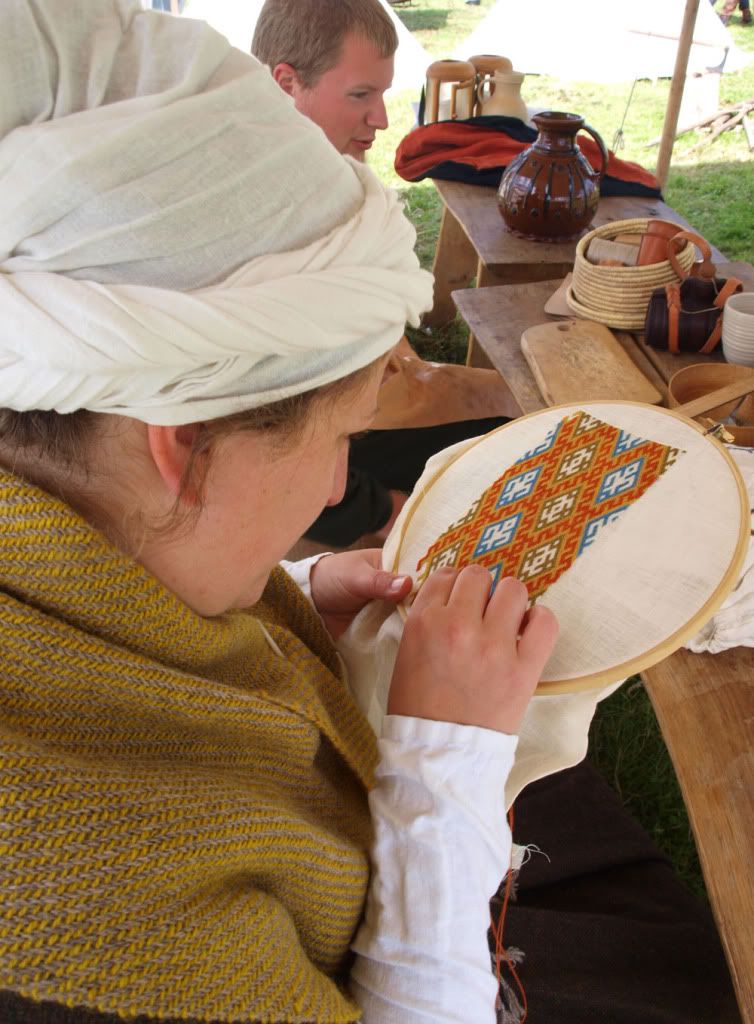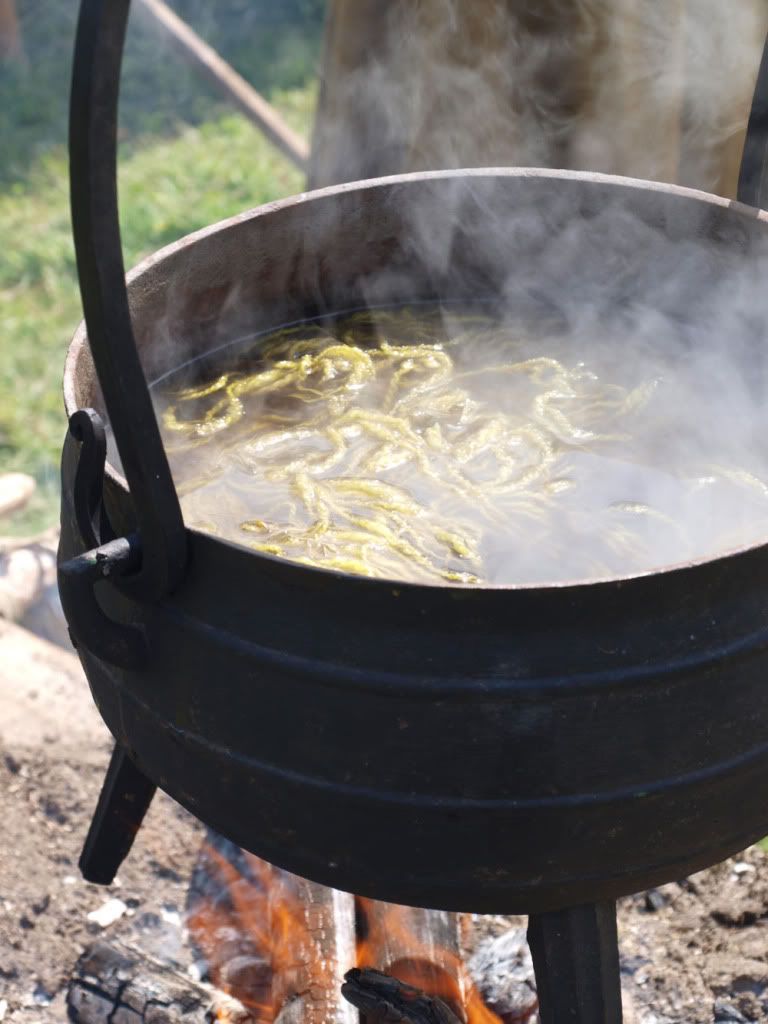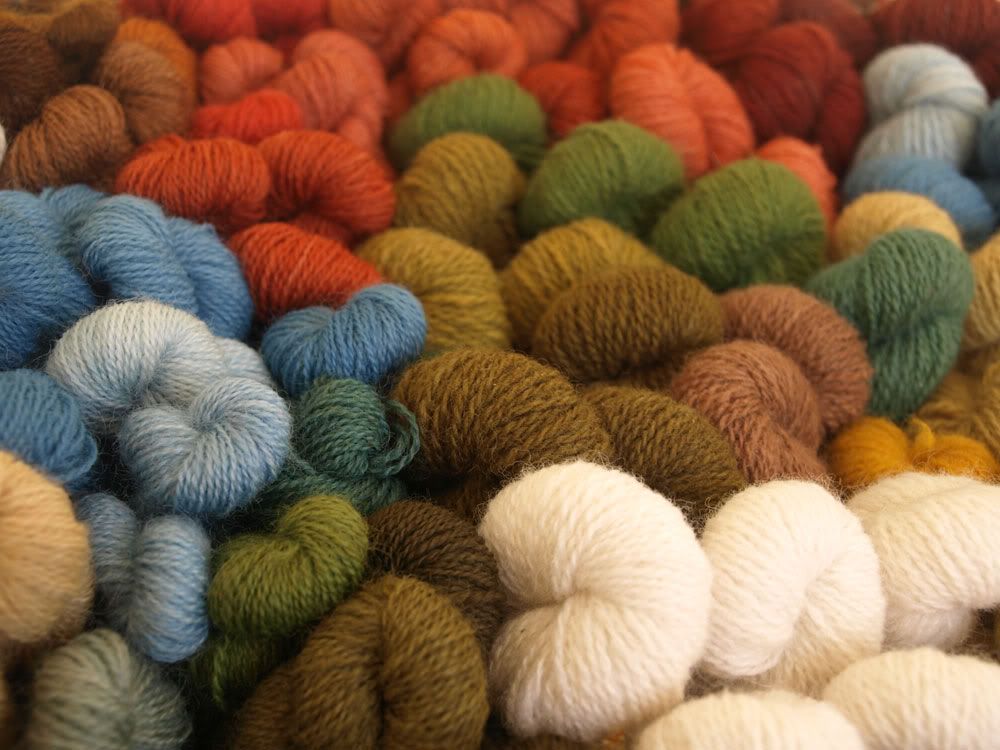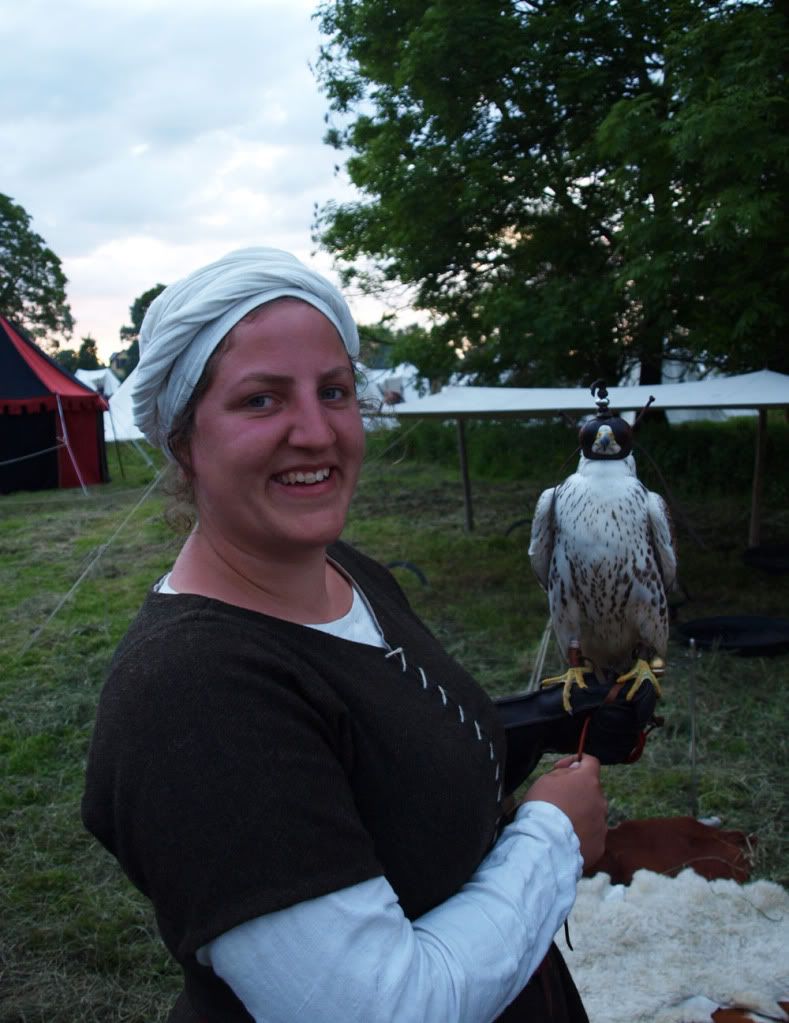I´m very sorry that I have been absent from the blog in quite a while but there have been so many things going on this summer. Although I have been busy I havn´t stopped making different medieval things. It is things that you have seen mentioned before on the blog and there is at the moment no new and exciting projects with need of source pictures and such. So this post is going to be pics of different things and opbjects that I have been working on/with. Sometimes much reading in a post isn´t always the best. So at the moment I´ll leave all the writing to Mikkel :0).

Working on my embroderi (which is now finished, and will be shown in a upcomming post)


Dyeing in an iron cauldron.

Here I´m washing the yarn that have been dyed with Saint John's Wort (on danish it´s called perikon)

Here are some of my dyes - the small bundles are embroidery wool which I sell on the markets that we attend. So fare there haven´t been much luck in the sales.

And this...I just had to show you that I have been so lucky to have tried to hold such a wonderfull bird :0)









Så kul att få se alla dina projekt! Superfint! Synd att garnet sålt så dåligt, jag hade garanterat köpt av dig om jag kommit förbi någon marknad!
ReplyDeleteHvor er det nogle smukke garner du har lavet! Jeg er meget imponeret - hvis jeg kunne finde ud af at brodere ville jeg helt klart købe af dig :-)
ReplyDeleteI look and do not believe:) What dye have you used to dye a wool in blue colour? About 90% of medieval society or more wore clothes in natural colours of wool and linen, because they could not afford to buy colored cloth.
ReplyDeleteSo I've asked, just because of curiosity. Regards )
To make the blue colour I have dyed with indigo. It was quite easy and made lots of beautiful blues.
ReplyDeleteFrom what book or source have you read that 90% of the medieval ddociety wore natrual coloured clothes?
Thanks for your answer, I was waiting for it:)
ReplyDeleteHow do you know indigo was known in medieval Europe? I was convinced it grew in America, West Africa and India at that time and came to Europe with Columbus or Vasco da Gama. Earlier to import it for example - from India it required a lot of money to pay for Arabic/Turkish traders, so only elites could allow to wear blue clothes. Remember that majority of medieval society were peasants. So I think that just wearing gray, ecry or brown wool would be safer than guessing if for example a man living in the city (average rich craftsman) could allow to buy colored cloth. The same is with red, green, purple, yellow colours, however they were cheaper. Dying was additional process to get finished product - wool fabric, what enlarged its price. Not-dyed wool was simply cheaper, that's why I think it was more popular.
Of course you may say that you have dyed it with your own hands, but ask yourself if a man living in medieval times have had so much time and will to do that. How many time he/she must have spent on everyday works, especially a woman, who boiled, washed clothes, tidied, etc. Nowadays you have a fast food, washing machine, vacuum cleaner and facebook. Dying was an occupation of a definite social group - guild of dyers, who did'nt spend time on harvesting, sheep shaving, but just dying cloth and selling it. But if you reenact princess of Burgundy or wife of Councilman of Magdeburg city - it's no problem, as I think.
I read that info in a russian book about dying in medieval times, but it was 1 or 2 years ago. I have access to several russian books related to dying. Unfortunately I don't remember in which I have read that, but I'm gonna search when I find time, because this topic is interesting - i think. In my country (in reenacting movement), blue, red or generally bright-dyed colours of cloth are perceived as wore by incorrectly-reconstructed-medieval-character because majority of them do not have appropriate inventory, which would justify their material status, for example silver replicas of jewellery, rich eating utensils, furniture, servants and so one.
Regards
It does stand to reason that peasants would not have time or inclination to dye fabrics, except perhaps for something particularly special, as simply living was an all day affair. HOWEVER, one must discount trade among peasants. People, gathering and living near one another, trade skills. Period. It's what they do. And one must also consider that not much is known about peasantry. Who would write about what peasants were doing?
ReplyDeleteI should have said: "...one must NOT discount trade among peasants..."
ReplyDeleteIt's a pretty safe bet that dying was neither discovered nor practiced by the aristocracy. It is quite possible that who wore the colors actually began the other way around. With aristocracy not wanting to look like peasants by wearing clothing that had been soaked in soup.
ReplyDeleteOnce color had been adopted by the more affluent citizens, it's possible that peasants were forbidden to wear specific colors, in public, but people crave happiness and pleasantries and arts and crafts are available to everyone and can be made of anything.
Nothing revered by the aristocracy of today, was discovered or invented by their aristocratic ancestry. Including the arts and trade that gave rise to wealth and the aristocracy, in the first place.
You can't go by what is written about the past. Who wrote it? Where was their attention AIMED? What were they NOT looking at? Who were they writing FOR? What would one who could read and write, when many could not, write ABOUT? What would they seek to record, by writing?
ReplyDeleteIt is very unlikely that anyone would have thought to write "A Day in the Life of a Peasant". Peasants were almost certainly happier than a superficial, easily bored aristocracy.
The seven deadly sins are not the sins of people who work, dawn to dusk, to put food on the table. They're the sins of the wealthy - sins born of boredom and social climbing.
Not all aristocracy is like that, obviously, but those who are NOT like that are considered "lower" in social status, by their aristocratic peers.
ReplyDelete